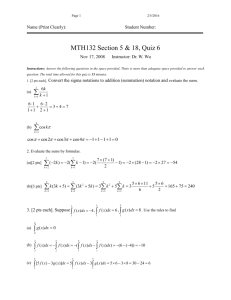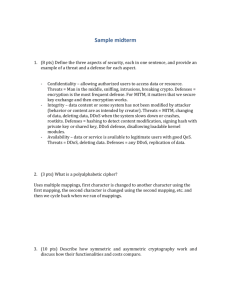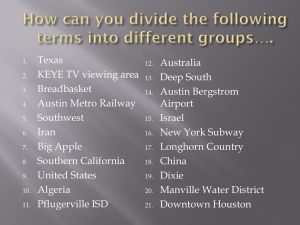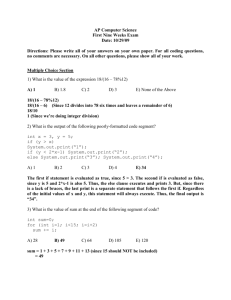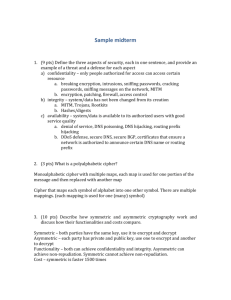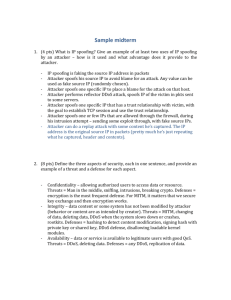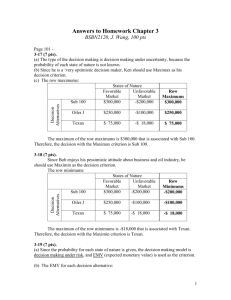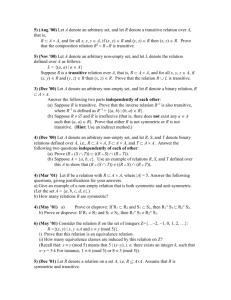Solution
advertisement
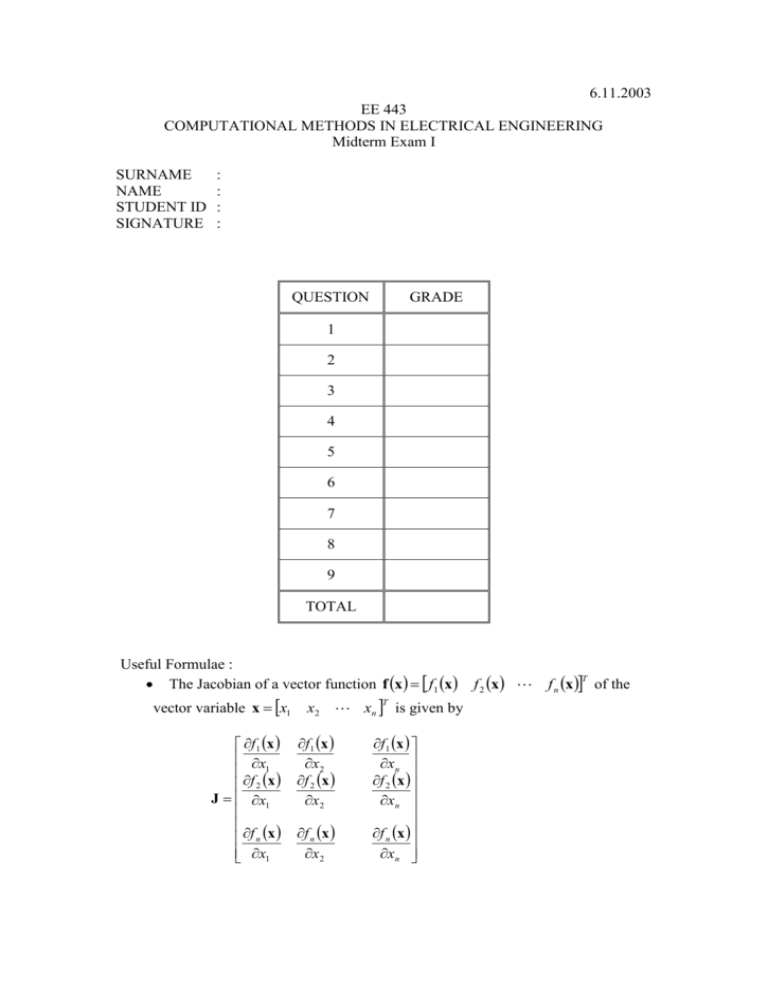
6.11.2003 EE 443 COMPUTATIONAL METHODS IN ELECTRICAL ENGINEERING Midterm Exam I SURNAME NAME STUDENT ID SIGNATURE : : : : QUESTION GRADE 1 2 3 4 5 6 7 8 9 TOTAL Useful Formulae : The Jacobian of a vector function f x f1 x vector variable x x1 f1 x x 1 f x 2 J x1 f n x x1 x2 xn is given by T f1 x x2 f 2 x x2 f n x x2 f1 x x n f 2 x x n f n x x n f 2 x f n x of the T 1) (15 pts.) Consider the polynomial x 3 3x 2 3x 1 which can be written in three different forms as i) ii) p x x 3 3x 2 3 x 1 qx x 3x 3x 1 iii) r x x 1 3 Assume that we want to evaluate this polynomial at x 2 by using fixed point arithmetic. The number x has a representation x̂ in this fixed point system, thus x the absolute and relative errors in x are x x xˆ and x , respectively. x Determine the absolute and relative errors in evaluating the polynomial at x 2 by using the three forms in terms of x . Assume that the coefficients have exact represantations in the fixed point arithmetic. Solution x x x , x x x, x x 2 i) x 3 3x x 3 3 x x 24x 3 x 2 2x 3 x 2 2 3 x 2 x 24x 3 x x 3 x 3 x x 6x p x 3 3 x 2 3 x 54x 27 x p p 27 x 27 x p 1 ii) x 3 x 3 x x 3 x x 3 x 3x x 3 x x x 3x x 3x x 3x 2 2 3x 3x 2 x 3x 3 3x x 3x 3 3x 3x x 3x 3 1 7x x 3x 3x 3x x 3x x 2 2 7 x q 7x q q 2 q 2 iii) x 1 x x 1 x x x 1 x 1 3 x 1 3x 3 r 3x r 3x 2) (10 pts.) Given the recursive formula yn 3 yn1 4 yn2 with initial values y 0 1 and y1 4 . Calculate the maximum number n for which y n can be calculated with double precision arithmetic using IEEE-754 standard. Solution y 2 3 y1 4 y 0 3 4 4 1 4 2 y3 3 y 2 4 y1 3 4 2 4 4 4 4 2 4 3 yn 4 n (assume! ) y n 1 3 y n 4 y n 1 3 4 n 4 4 n 1 4 4 n 4 n 1 (proof by induction! ) IEEE-754 double precision standard uses 64 bits with 11 bits reserved for the exponent in excess 1023 format. In addition ‘7FF’H in exponent is reserved to denote ‘inf’. Thus the exponent can at most be ‘7FE’H corresponding to 211 2 1023 1023 . The mantissa can at most be about 1.9999... and a number slightly greater than 21023 can be represented but 21024 is ‘inf’. 21024 4 512 inf Hence y512 is ‘inf’ but y511 4 511 21022 can be calculated. 3) (15 pts.) Decompose the following matrix A into LU form 5 4 A 1 2 4 2 2 1 1 0 4 2 1 4 1 1 Solution 4 1 1 4 1 1 5 5 d12 0.8 4 2 0 4 e . r .o . 0 1.2 0.8 3.2 A d13 0.2 1 2 4 d 23 1 0 1.2 4.2 1 1.2 d14 0.4 2 d 24 0.5 0 0.6 1 2 1 2.4 1.4 4 1 1 4 1 1 5 5 0 1.2 0.8 3.2 0 1.2 0.8 3.2 e . r .o . e . r .o . 0 0 0 5 2 0 5 2 d 34 0.4 0 0 2 3 0 0 3.8 0 Hence 1 0 0 0.8 1 0 L 0.2 1 1 0.4 0.5 0.4 0 0 0 1 4 1 1 5 0 1.2 0.8 3.2 U 0 0 5 2 0 0 3.8 0 or in compact form 4 1 1 5 0.8 1.2 0.8 3.2 LU 0.2 1 5 2 0.4 0.5 0.4 3.8 4) (15 pts.) Use Gauss-Seidel iterations to determine a solution of the following system of non-linear equations. x2 y 4 0 y2 x 5 0 Use x0 1 and y 0 1 as a starting point and carry out the calculations until your final estimate is correct to 3 decimal places. Solution x0 y 0 1 From the first equation x12 1 4 0 x1 3 1.732 From the second equation y12 1.732 5 0 y1 5 1.732 1.808 Going on in this way we get x 22 1.808 4 0 x 2 4 1.808 1.481 y 22 1.481 5 0 y 2 5 1.481 1.876 x32 1.876 4 0 x3 4 1.876 1.457 y32 1.457 5 0 y3 5 1.457 1.882 x 42 1.882 4 0 x3 4 1.882 1.455 y 42 1.455 5 0 y3 5 1.455 1.882 We see that x4 x3 and y 4 y3 in three decimal places hence we can stop iterating. Solution: x 1.455 y 1.882 5) (15 pts.) Use Newton’s method to determine a solution of the following system of non-linear equations. x2 y 4 0 y2 x 4 0 Use x0 1 and y 0 1 as a starting point and carry out the calculations for 2 steps. Solution x 2 y 4 2 x 1 1 J x, y f x , y 2 s0 1 2 y 1 y x 4 2 1 2 1 2 1 J0 J 01 f0 3 1 2 1 2 2 1 1 2 1 2 5 / 3 s1 s 0 J 01f 0 1 3 1 2 2 5 / 3 1 1 10 / 3 4 / 9 9 10 / 3 J1 J 11 f1 10 / 3 91 1 10 / 3 1 4 / 9 1 4 / 9 61 / 39 1.5641 5 / 3 9 10 / 3 s 2 s1 J 11f1 5 / 3 91 1 10 / 3 4 / 9 61 / 39 1.5641 6) (10 pts.) The Conjugate Gradient Method can only be applied to systems of linear equations with positive determinate coefficient matrix, i.e., for systems Ax b where A is a positive determinate matrix. For non-symmetric and/or indefinite systems, one approach is to apply the Conjugate Gradient Method to A T Ax A T b where A T denotes the transpose of the matrix A. Prove that AT A is a symmetric, positive definite matrix. Solution A A A A A A Hence A A is symmetric x A A x x A Ax xA Ax Ax 0 x T T T T T T T T T T T T AT A is non-negative definite. Ax b multiply both sides by A T A T Ax A T b equation. hence the solutions will include the solutions of the original 7) (10 pts.) Find the dominant eigenvalue, d , and a corresponding eigenvector, e d , of the matrix 1 11 40 A 2 12 40 1 1 0 using the power method. Solution 1 Take x 0 1 1 1 11 40 1 50 y 0 2 12 40 1 50 1 1 0 1 0 x1 y 0 / y 0 50 d ,1 y1 10 d , 2 1 1 0 T 1 11 40 1 10 y 1 2 12 40 1 10 1 1 0 0 0 x 2 y1 / y1 y0 1 1 0 x1 T Hence d 10, e d 1 1 0 T 8) (10 pts.) Discuss whether the following matrices are positive definite or not: 2 7 3 25 2 11 4 3 A 7 4 16 1 3 3 1 17 7 1 2 3 1 11 1 2 B 2 1 6 2 2 2 15 3 18 2 2 6 C 3 1 8 0 8 1 0 6 1 2 15 3 Determine also the 1 and norms of these matrices. Solution A is symmetric; for row 1 : 25>2+7+3=12 for row 2 : 11>2+4+3=9 for row 3 : 16>7+4+1=12 for row 4 : 17>3+3+1=7 Hence A is diagonally dominant and all diagonal entries are positive, hence A is positive definite. B is symmetric but one diagonal element is negative. In fact Gerschgorin circle theorem shows that B has a negative eigenvalue (row 2) and 3 positive eigenvalues (other rows). Hence B is indefinite. C is not symmetric, however Gerschgorin circle theorem shows that all eigenvalues are positive, hence C is positive definite. 2 7 3 25 2 11 4 3 A 7 4 16 1 3 3 1 17 37 20 28 24 2 7 3 25 20 2 11 4 3 28 B 7 4 16 1 24 3 3 1 17 13 15 11 22 37 13 15 11 22 A1 A B1 B 2 7 3 31 25 2 11 4 3 9 C 7 4 16 1 11 3 3 1 17 25 31 9 12 24 37 22 C 1 C 31

